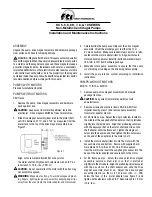
P S - 7 0 4 F o u r - C h a n n e l P o w e r S u p p l y
5 - 2
voices and instruments on stage. IFB (program interrupt) disconnects the audio
source while the
talk
button on the main station is pushed.
ISO:
A private conversation path. An ISO channel allows one to simply push a
button and transfer themselves and the person they wish to speak with to an
isolated channel.
Linking:
Linking ties separate channels into one single party line.
Main Station:
This is a product that includes both the ability to communicate
with multiple channels without connecting them together, and to power all the
stations connected to these channels.
Master Station:
A remote station which needs AC power to operate.
Multi-Channel:
More than one channel.
Party Line (P.L.):
Intercom system in which all people talking on the system can
talk or listen to each other simultaneously. Also called conferencing.
Point to Point:
One path to one person.
Program:
Audio source that is fed into the intercom channels.
Program Interrupt:
Disconnects the audio source while the
talk
button on the
main station is pushed (IFB).
Remote Mic Kill (RMK):
The ability for certain main stations to shut off all
microphones on beltpacks in a system.
Remote Station:
Like the beltpack, this would be any of the products connected
to the intercom line that allow duplex or half-duplex conversation, but do not
contain a power supply.
Sidetone:
This is your own voice heard in your earphone as you are speaking.
Stage Announce (SA):
Redirects output of the main station's microphone to an
external destination (such as a PA system).
Station:
A station is connected to one or more channels. For example, if you
have six people who need to hear one director, you have a seven-station
single-channel need. If the same director needs to speak privately to any one of
the six, add a second channel. You now have a seven-station, two-channel system.
Termination:
Passive network that is connected in each channel, usually on the
power supply or main station.





































